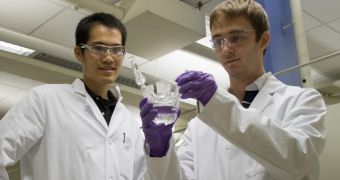Researchers at the Massachusetts Institute of Technology (MIT), in Cambridge, recently used abundant and inexpensive materials to create a new type of high-efficiency oxygen catalyst. They say that the chemical could be used for both hydrogen-based fuel production and improving rechargeable batteries.
The most remarkable thing about the new substance is that it releases oxygen from molecules at about 10 times the rate of other catalysts. Primarily, the research team tested their chemical on water.
The omnipresent liquid is made up of two hydrogen atoms bound to a single oxygen atom. Splitting this molecule – through hydrolysis, for example – releases hydrogen and oxygen atoms, which can then be harvested individually and used for separate applications.
MIT experts say that their catalyst is the most efficient ever developed, in terms of splitting water. As such, it may find important applications in improving advanced energy-storage systems. By using the chemical, it may become possible to develop high-efficiency electrolyzers.
These devices are a mainstay on hydrogen fuel production lines, as well as inside rechargeable batteries. Every improvement brought to a stage of these manufacturing processes can result in increased overall efficiency and storage capacity.
The main components of the new catalyst are cobalt, iron and oxygen, alongside a host of other metals. Interestingly, the team selected this particular combination following a systematic experimental study.
That investigation looked at how 10 chemical compounds would act during the Oxygen Evolution Reaction (OER), which splits water. The research was purely theoretical, yet its results turned out to be valid in practice as well.
Details of the new study were published in the October 28 issue of the top journal Science. The work was authored by MIT professor Yang Shao-Horn, mechanical engineering graduate student Kevin J. May and materials science and engineering graduate student Jin Suntivich.
“We not only identified a fundamental principle [of OER activity of different chemicals,] but also we actually found this new compound” by relying solely on these predictions, Shao-Horn explains.
The investigators holds an appointment as the Gail E. Kendall (1978) associate professor of mechanical engineering and materials science and engineering at MIT. The study was supported by the Department of Energy Hydrogen Initiative, the National Science Foundation, the Toyota Motor Corporation and the Chesonis Foundation.

 14 DAY TRIAL //
14 DAY TRIAL //